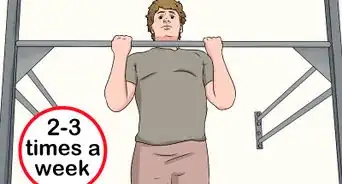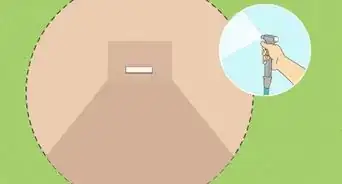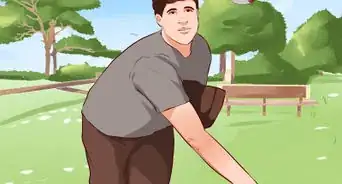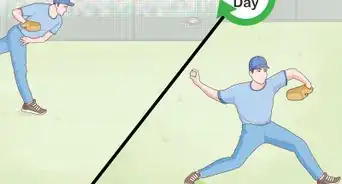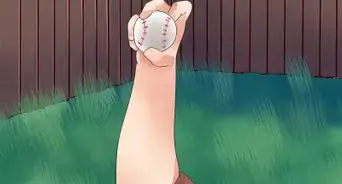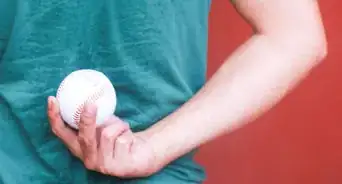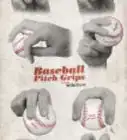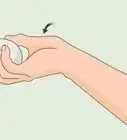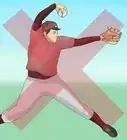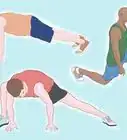This article was co-authored by Isaac Hess. Isaac Hess is a Baseball Coach, Instructor, and the Founder of MADE Baseball Development and Champion Mindset Training Program, a baseball training program based in Los Angeles, California. Isaac has over 14 years of experience coaching baseball and specializes in private lessons and tournaments. He has played baseball for both professional and collegiate leagues including Washington State University and the University of Arizona. Isaac was ranked as one of Baseball America's top 10 prospects for 2007 and 2008. He earned a BS in Regional Development from the University of Arizona in 2007.
There are 12 references cited in this article, which can be found at the bottom of the page.
wikiHow marks an article as reader-approved once it receives enough positive feedback. In this case, 90% of readers who voted found the article helpful, earning it our reader-approved status.
This article has been viewed 262,954 times.
The fastball is the most important pitch in baseball and you’ll need to master it before moving onto other types of pitches. Whether you’re in little league or the majors, you should be constantly trying to improve your body’s physical capabilities and technique to maximize the velocity, movement and control of the pitch. With some adjustments and a lot of practice, you can throw more strikes and make batters whiff.
Steps
Developing Your Technique
-
1Perfect your grip. There are two primary grips for the fastball: the four-seam and the two-seam. The four-seam generally gathers more velocity but some pitchers find the two-seam more comfortable and easier to command.[1] Many experienced pitchers will switch between the two options when they want to emphasize velocity or movement respectively but you should stick with one until you’re fully comfortable with it.
- For the four-seam grip, place your index and middle fingers across the seams where they form a horse-shoe shape with a comfortable amount of space between them. Have your ring and pinky fingers close together and your thumb gently resting underneath the ball.[2]
- The two-seam grip involves the same general configuration of your fingers but with the index and middle finger following along the seams where they are close together. Once you’ve mastered the two-seam grip, your fastball should have some movement toward your pitching hand’s side of the plate (i.e. a right handed pitcher’s two-seam fastball with break inside on a right-handed hitter).[3]
-
2Perfect your stride. You should be generating the majority of your power from your lunging motion toward the plate.
- The pitching mound is elevated for a reason. After you lift your step leg, use the momentum of your body falling forward to generate power for your pitch.[4]
- Determine the ideal spot for your step foot to land so that you’re maximizing your forward momentum without overextending. Practice hitting that spot with your foot until it’s second nature. You may even want to practice your lunge motion without actually pitching the ball so you can focus on it.
Advertisement -
3Follow through with your motion. If you rigidly stop your pitching motion as soon as you release the ball, you’ll lose some velocity and accuracy.
- Your pitching hand should end up near your hip on the opposite side of your body.
-
4Command the pitch, don’t aim. One of the most ubiquitous and confusing pieces of advice you’ll hear from baseball coaches is that you shouldn’t aim your pitches. This is not meant to imply that you shouldn’t care about where your pitch lands. However, if you’re overly focused on guiding the pitch to a specific spot in the zone, it will compromise the velocity and general effectiveness of the pitch.[5]
- Pitchers use the term ‘command’ to describe the approach of using your delivery motion to locate pitches rather than simply aiming the ball. This may sound vague if you’re new to pitching but will make more sense as you work on your technique.
- Point your step foot toward the inner or outer part of the plate when you’re trying to command the ball to those locations.[6]
- As you’re developing your delivery, visualize the ball landing in a specific spot and keep practicing until it works. Use the muscle memory of that delivery motion to build your command.[7]
- Commanding without aiming is one of the more difficult aspects of pitching and even major leaguers can struggle with it. You’ll need a lot of patience and practice.
Building Arm Strength
-
1Focus on your triceps and forearm muscles. While most people associate biceps with arm strength, the most important pitching muscles in your arm are actually the flexor muscles in your forearm and your triceps. Focus on strength-building and flexibility exercises in these areas to build pitching velocity and reduce the risk of injury.[8]
- Try some reverse barbell curls. Face away from the barbell and grip it with both hands shoulder-length apart from behind your back. Bend your elbows slightly and let your wrists do the work when you curl the barbell up toward your back. Start with a light-weight barbell and a limited number of repetitions before until you’re comfortable increasing. This will build forearm and wrist strength.
- Try some tricep extensions. You’ll need a cable pulley which is available at most commercial gyms. Grip the rope or handle-bar attachment in front of you and pull it down with your elbows ending up straightened and by your sides. Raise your hands back to the starting position slowly. Start with a light-weight pulley and a small number of repetitions until you’re comfortable increasing.[9]
-
2Build rotator cuff flexibility. The majority of pitching injuries take place in the shoulder region so building strength and flexibility in this area is essential as you try to ramp up your fastball velocity.[10]
- Try some shoulder flexions. You’ll need some anchored tubing which is available at most commercial gyms. Stand facing away from the anchor with the tubing in your hands resting at your sides. Extend your arms out in front of your face with your elbows and wrists straight and then return to your starting position. Start with a limited number of repetitions until you’re comfortable increasing.[11]
-
3Strengthen your core. Your arms aren’t the only part of your body you work when pitching. A lot of your power will be derived from your legs, hips and abdomen. Strengthen these areas, collectively known as your ‘core,’ to maximize your pitching ability.[12]
- Try some medicine ball rotational throws. You’ll need a medicine ball and a workout partner. Sit on the floor and hold the ball close to your chest with your elbows pointing outward. Keep your legs and lower body still during the exercise and start with your upper body rotated away from your partner. Rotate toward your partner and pass the ball by extending both elbows forward like a basketball pass. Start with a light-weight ball and a limited number of repetitions until you’re comfortable increasing.[13]
- Try some bicycle crunches. Lay flat on your back with one leg out and both hands on your head. Crunch your opposite knee into your opposite elbow. Start with slow movements and limited repetitions until you’re comfortable increasing.
Expert Q&A
-
QuestionWhat are the best exercises if I want to throw faster?
 Isaac HessIsaac Hess is a Baseball Coach, Instructor, and the Founder of MADE Baseball Development and Champion Mindset Training Program, a baseball training program based in Los Angeles, California. Isaac has over 14 years of experience coaching baseball and specializes in private lessons and tournaments. He has played baseball for both professional and collegiate leagues including Washington State University and the University of Arizona. Isaac was ranked as one of Baseball America's top 10 prospects for 2007 and 2008. He earned a BS in Regional Development from the University of Arizona in 2007.
Isaac HessIsaac Hess is a Baseball Coach, Instructor, and the Founder of MADE Baseball Development and Champion Mindset Training Program, a baseball training program based in Los Angeles, California. Isaac has over 14 years of experience coaching baseball and specializes in private lessons and tournaments. He has played baseball for both professional and collegiate leagues including Washington State University and the University of Arizona. Isaac was ranked as one of Baseball America's top 10 prospects for 2007 and 2008. He earned a BS in Regional Development from the University of Arizona in 2007.
Baseball Coach & Instructor Push ups are a great exercise if you want to build your upper body and throwing strength. If you're doing dumbbell exercises, use lighter weights (between 2-5 pounds) instead of heavier weights to develop leaner muscles. Shoulder raises and side shoulder raises are great exercises. Resistance bands, tubing, and Jaeger bands are also good for building arm strength.
Push ups are a great exercise if you want to build your upper body and throwing strength. If you're doing dumbbell exercises, use lighter weights (between 2-5 pounds) instead of heavier weights to develop leaner muscles. Shoulder raises and side shoulder raises are great exercises. Resistance bands, tubing, and Jaeger bands are also good for building arm strength. -
QuestionDoes having an unusual pitching stance affect the way someone pitches?
 Community AnswerIt depends, if your stance makes you take longer to release, two things will happen: 1) you will not throw as hard if you take longer to get to home plate, and 2) runners will be able to steal easier if it takes longer to get to home.
Community AnswerIt depends, if your stance makes you take longer to release, two things will happen: 1) you will not throw as hard if you take longer to get to home plate, and 2) runners will be able to steal easier if it takes longer to get to home. -
QuestionI am 12 years old and in major league and I currently have a 53MPH fastball, I want to control and throw my fastball harder. Any tips?
 DonaganTop AnswererAs you get stronger, your speed will improve. At 12 years old, don't push it too hard. A young arm like yours is vulnerable to injury from throwing a lot of fastballs, because your arm muscles have not completely developed yet.
DonaganTop AnswererAs you get stronger, your speed will improve. At 12 years old, don't push it too hard. A young arm like yours is vulnerable to injury from throwing a lot of fastballs, because your arm muscles have not completely developed yet.
References
- ↑ http://www.thecompletepitcher.com/pitching_grips.htm
- ↑ http://www.thecompletepitcher.com/pitching_grips.htm
- ↑ http://www.baseball-pitching-tips.com/two-seam.html
- ↑ Isaac Hess. Baseball Coach & Instructor. Expert Interview. 20 March 2020.
- ↑ http://baseballnews.com/special-report-future-of-pitching-command/
- ↑ http://www.youthpitching.com/mechanics.html
- ↑ http://www.baseball-tutorials.com/baseballpitchingdrills/
- ↑ http://www.topvelocity.net/pain-in-triceps-and-biceps-when-pitching/
- ↑ http://www.bodybuilding.com/exercises/detail/view/name/standing-dumbbell-triceps-extension
- ↑ https://www.drivelinebaseball.com/2011/06/3-great-ways-to-increase-shoulder-strength-and-flexibility/
- ↑ http://ericcressey.com/limited-shoulder-flexion-elbow-injuries-pitchers
- ↑ http://www.thecompletepitcher.com/pitching_core_training.htm
- ↑ Isaac Hess. Baseball Coach & Instructor. Expert Interview. 20 March 2020.
About This Article
The key to throwing a faster fastball is in your technique and physical strength. Generate as much power as you can when you lunge forward to pitch the ball. Make sure you follow through after releasing the ball so you don’t lose any power. You can also use the 4-seam grip for a little extra power. Just place your index and middle fingers across the seams where they form a horse-shoe shape with your ring and pinky fingers close together and your thumb gently resting underneath the ball. To build your arm strength, practice exercises like reverse barbell curls, push ups, and pulling cable pulleys in the gym. You should also strengthen your core with exercises like sit ups, crunches, and planks. For more tips, including how to command your pitch to generate extra power, read on!
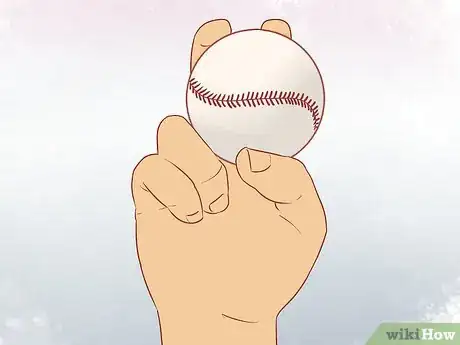
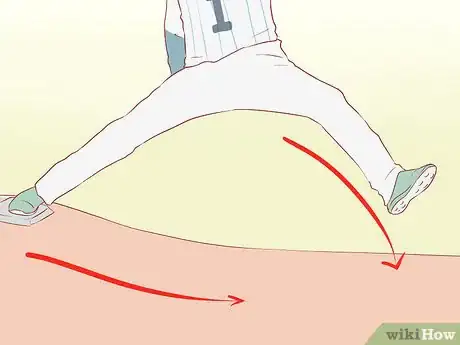

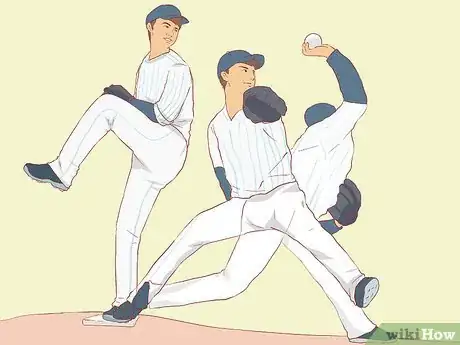
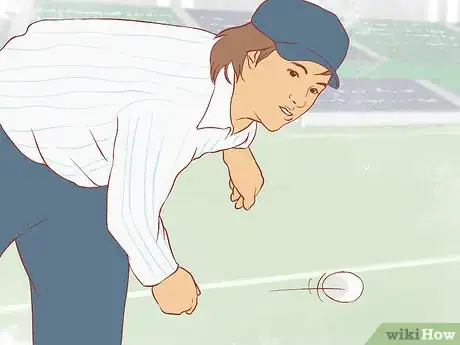
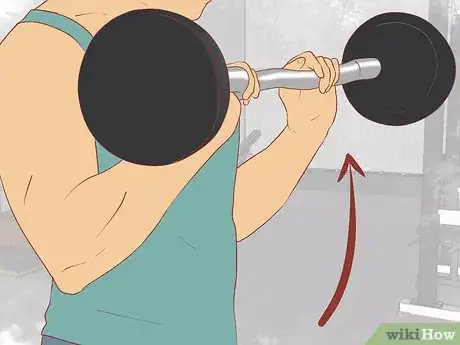
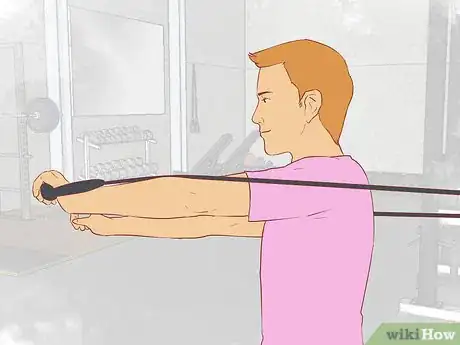
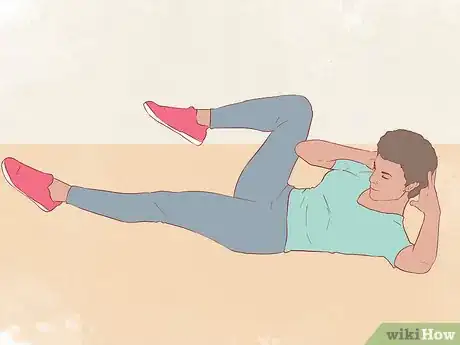

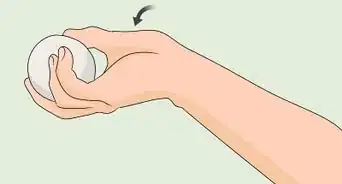
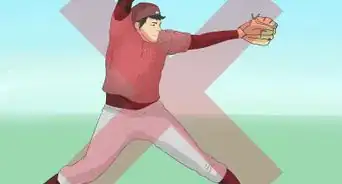
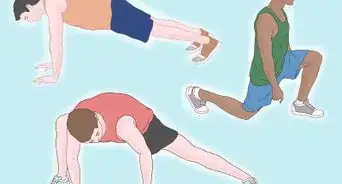
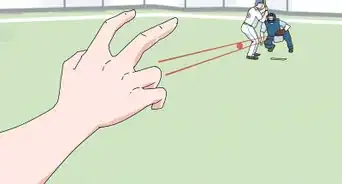
-Step-8.webp)
